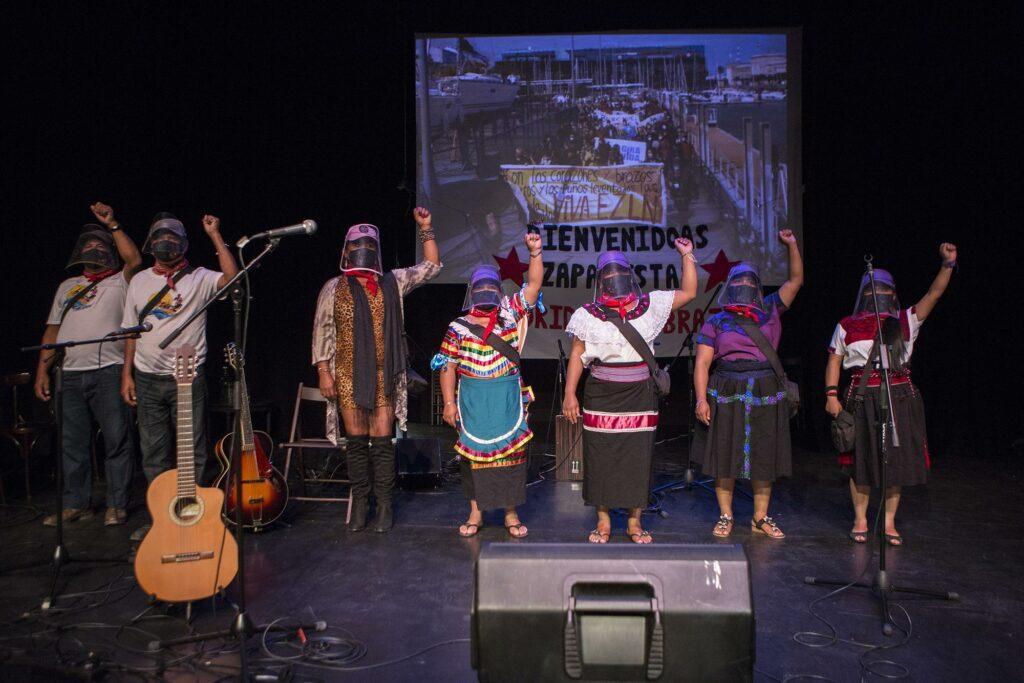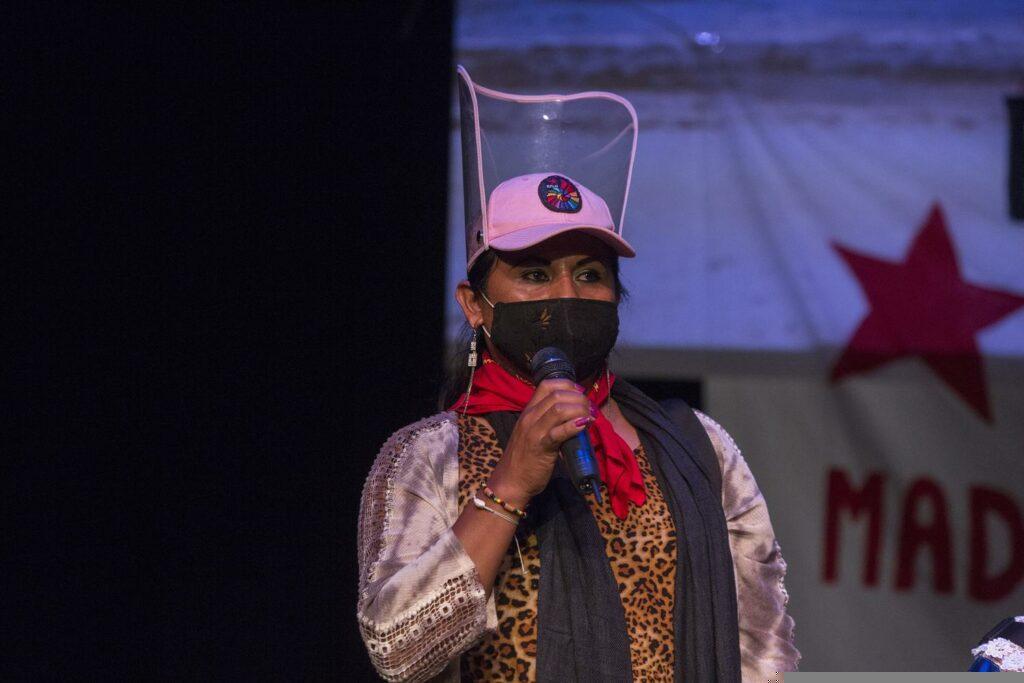
Tenth text in the series commemorating the 30th anniversary of the Zapatista uprising. This time, the author gives relevance to the concept of the non-binary “otroa” of Zapatismo because it focuses on the other, the external, the discriminated, in order to establish a political definition from that place.
Knee-high boots, jeans, an animal print blouse, a pink cap and a mask (because it is the year 2021). On the boat La Montaña came Squadron 421, the Zapatista maritime delegation of the Journey for Life, made up of four compañeras, two compañeros and one compañeroa: Marijose, loa otroa1 (the other).
At first glance, here in Europe, ‘loa otroa‘ might sound like a mythological animal, but as María José herself explained, loa otroa of the Zapatista communities sums up all the dissidence, all that is queer, of lesbians, gays, bisexuals, trans and other identities deployed in their collective representation in the West.
In her past, she experienced something very similar to any queer person from a rural environment: confused childhood, adolescent adventures in the city, furtive change of clothes when leaving home, new friendships at night. There came a time when Marijose wondered whether to enter a monastery or take up arms and go up to the mountains to fight with the EZLN. All overflowing femininity had to be eradicated, the feathers domesticated among men.

But in the Zapatista communities, Marijose told us that nobody rejected her and nobody is rejected, because they are clear that the enemy to beat is the patriarchal capitalist system. All the violence she experienced with the men from outside, has not occurred with the men from inside. She shared all of this in the Koch Areal squat in Zurich. By then Marijose and the other compañerxs had already been in Europe for 73 days.
They disembarked in Vigo after 50 days crossing the Atlantic, as a replica of the journey made by the Spanish ships 500 years ago to take Mexico/Tenochtitlan. A reverse voyage by boat to delegitimize the discourse of colonization posed from Europe to America. A journey in the midst of a symbolic and narrative pandemic. But Marijose seems more like a pirate than a colonizer.
Contemporary imagery has turned the figures of pirates into characters who, from their marginality, knew how to establish strategies of joy and freedom, as well as self-managed communities with a greater or lesser hierarchy depending on the case. There are in particular two recurring 18th century characters in today’s queer imaginary: Anne Bonny and Mary Read, two women born in the British Isles who diverged from the social norms to enlist on the high seas as pirates, dressed as men at least during battles. This alternation between feminine and masculine easily exemplifies the iconic nature of these two pirates. Even before donning men’s attire, Anne Bonny and Mary Read were already breaching the family/state mandate by rejecting marriage and throwing themselves into the pirate life, fleeing the dichotomous norm of male-production and female-reproduction roles.
In the book Villains of All Nations. Atlantic pirates in their golden age, the author Marcus Rediker, says of them: “Bonny and Read posed their greatest challenge to state authority by choosing the pirate life, which was on the one hand another experience of class and not least, an experience of freedom in its own way.” A life of freedom chosen by their own protagonists, thrown into the present in the form of a mythological tale, a testimony that comes to us like a message in a bottle. To Mary and Anne let me add, now, Marijose.
Nor is Marijose the first dissident figure in Zapatista narratives. Already years ago there was frequent talk of Magdalena, a sex worker who entered into a relationship with Elías Contreras, an investigative commissioner of the EZLN, and who was murdered by the police. A story situated, as befits the utopian imaginary, between reality and legend, and collected, among other places, in the novel written by Subcomandante Marcos and writer Paco Ignacio Taibo II in 2005, Muertos Incómodos (Inconvenient Dead). Subcomandante Marcos would later say of her at the Festival of Dignified Rage in 2009: “La Magdalena was a ‘compañeroa.’ Whoever thinks that she, or he, according to him, is a literary character is mistaken.”I don’t know how the concept of ‘otroa’ was forged. That representation of the non-binary does not appear in the novel, and in the documentation of those years sexual dissidence in the Zapatista community still receives the same names that are used or have been used in the West: homosexuals, lesbians, transsexuals or transvestites. It is precisely in the acts of 2009 when Subcomandante Marcos indicates: “We look for our own way and we arrive at what we have called compañeroa.”
The concept of otroa is significant because it focuses on the other, the external, the discriminated, in order to establish a political definition from that place. One of the experiences of otroas that our collectives can learn from is to understand an umbrella united by difference. We have fomented an unstoppable enumeration of acronyms in pursuit of visibility that has contributed to the development of identities that have been used for their own commercialization. It is a division by acronyms at a horizontal level, which differentiates us from one another, less politicized every day as we lose the anti-capitalist charge demanded by the critical Prides, or as the Zapatistas indicated in the Act for sexual diversity in the City of Juarez in 2006: “We have also learned to respect, not only the existence of the workers and sex workers, but also their struggle, the ways in which they are organizing themselves. Up there (…) there is also a process of confronting differences and these organizations.”
In the use of ‘up there’ a division is traced of a space of privilege from where power is articulated and another space, ‘that from below’ it is understood, where externalities unfold without the option to intervene. That is to say, a vertical difference, of class, in our terms, instead of a horizontal difference of identities. As Marijose indicated in telling her story, discrimination is diminished when the focus is on eliminating the patriarchal capitalist system (upwards) rather than a process of correction of equals (sideways). We need to understand ourselves as a pirate community, in transition, dissident of binarism, yet in communion with all people engaged in the ‘here below’ of whom we are a part.
This top-down message may easily sound populist in Europe and at this point in history, nevertheless I deliberately let myself be affected by the Zapatista ideology to put forward the following idea. The indigenous communities have seen their traditional ways of life transformed by the incorporation of colonization processes, as in so many other places where some civilizations are taken over by others, in the most radical of cases, or affected, in the lightest of cases. A cultural invasion that takes place from top to bottom by the civilization that makes the most effective use of violence. It is probably a good idea to exchange violence for appreciation and establish a bottom-up inclusion. To learn from difference, to embrace it honestly. “The struggle for difference is a struggle for life, for existence,” words that were also taken up in the Act for sexual diversity.
The Zapatista communities have been demonstrating for 30 years an inventive capacity outside of neoliberal logic that we can point to from where we are in Europe and learn from. I write this message thinking of the compañeras at my side, but then I put it in a bottle and throw it into the sea. With the wish that it reaches my compañeroas on the other side.
Original text by Milanes Rivas published in El Salto on July 28th, 2024.
Translation by Schools for Chiapas.
Footnotes
- Using both masculine and feminine endings, loa otroa refers to the non-binary other